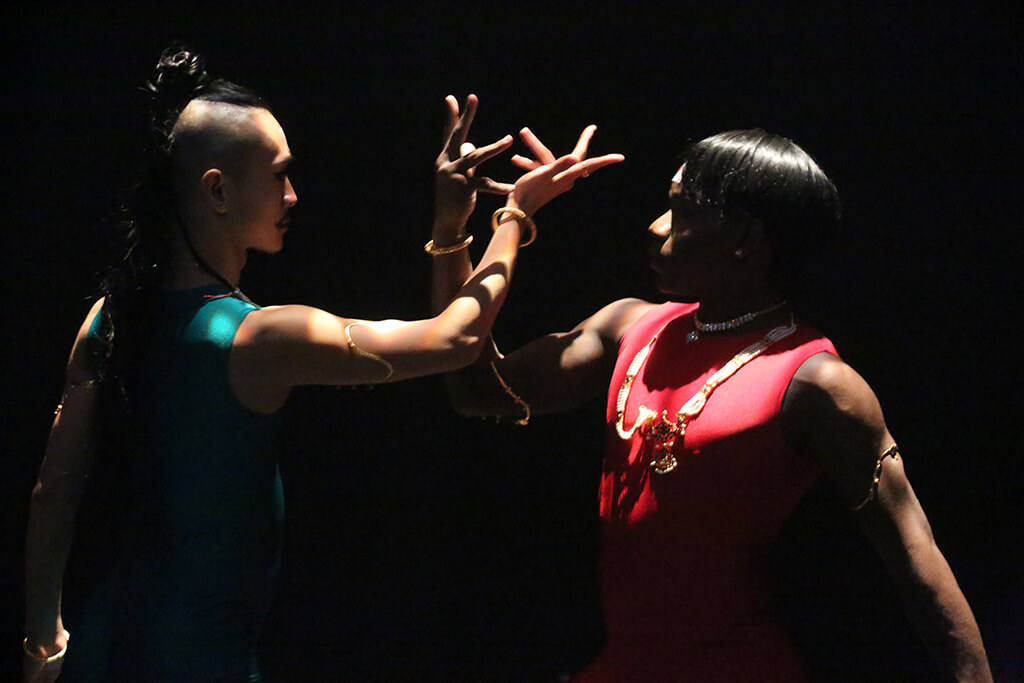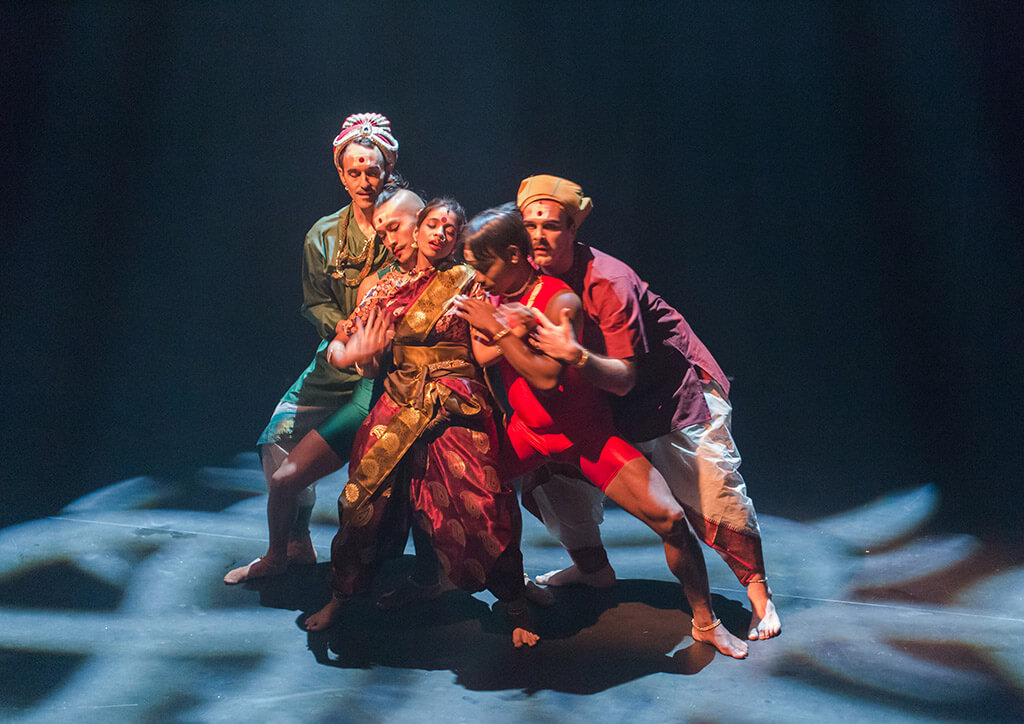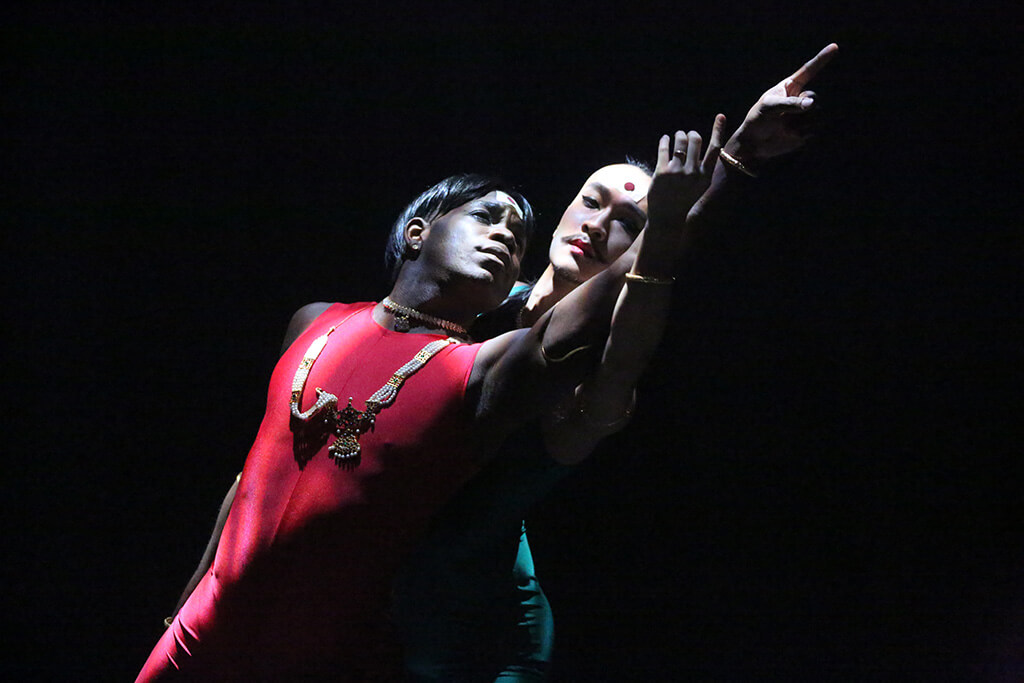
The Man Who Married Himself. Toronto Masque Theatre. At Streetcar Crowsnest Theatre. March 10 & 11.
Creativity and innovation are words many of us feel we have to live by in order to be considered successful. It’s an appealing prospect to live in the perpetual afterglow of smashed glass ceilings, discarded boxes, and punctured boundaries. It’s so appealing that we often forget that not all creative projects amount to more than the collective effort that went into them.
As far as the arts are concerned, Toronto Masque Theatre’s The Man Who Married Himself makes that point. Under the ever-creative artistic direction of Larry Beckwith, a collection of artists from a variety of disciplines have come together to re-tell an Indian-origin fable of a prince who decides that the best way to find the ideal wife is to split himself in two. It is a fable that speaks to our times on so many levels, from narcissistic male leadership to the fluidity of gender identity. The play’s execution also includes a variety of cultural bridges between East and West and between races.
The artists involved showed off their best at the premiere at Streetcar Crowsnest Theatre on Friday night. The simple staging in a wonderful new theatre space in the now gentrified intersection of Riverdale and Leslieville in Toronto’s east end is a tribute to practical creativity. But despite many wonderful elements, the hour-long work is not great theatre.

At the end of the performance, I thought how much more satisfying it would have been to get a concert version of Anna Chatterton’s libretto, brought to life by Juliet Palmer’s gem of a score. I would have been able to appreciate the cleverness of Chatterton’s language, its layering and repetition, underscored by music that conveys subtle as well as abrupt shifts of emotion, creating deep atmosphere, and straddling ethnic influences using a minimum of musical means.
I also would have been able to appreciate countertenor Scott Belluz, deftly switching between his head and chest voices to highlight the gender issues being played out in the story. Susha, a vocalist from the Indian classical tradition nimbly embodied the newly created spouse, and jazz singer Alex Samaras was solid as her secret lover.
The chamber ensemble — portatif organ, percussion, cello, violin, clarinet, and flute — that rendered the music under Beckwith’s direction was excellent, balancing perfectly with the voices in the intimate theatre space.

In a concert performance, I would probably not have been struck by how the text, which switches back and forth between the first and third person, stylizes the issues and emotions presented by the fable, keeping the characters and their emotions at a far distance. One of the reasons opera from all eras continues to appeal to new generations of fans and creators is that the best efforts focus and intensify emotions, connecting us powerfully to the characters and the issues they face. This play does the opposite.
Whether consciously or not, the responsibility of focusing and intensifying emotion in The Man Who Married Himself falls on two dancers, Jelani and Sze-Yang Ade-Lam. In motion through the bulk of the play, the dancers expressed what the libretto couldn’t, asking the audience to take in their slow-moving choreography (by Hari Krishnan) as an additional dimension. But I found my attention split and focus muddled by having the figurative and literal colliding on stage throughout the story. Despite the dancers, the stage direction (Marie-Nathalie Lacoursière) felt static, and Gabriel Cropley’s lighting could only achieve so much, despite a profusion of stage smoke.
Despite the beauty of the text and music, the fine dance, good singers and instrumentalists, not being able to identify with the characters and their emotions on stage made the 60 minutes feel much longer than they were.
The Man Who Married Himself is creative. It is innovative. But those qualities do not guarantee great theatre. There are two more performances on Saturday.
—
Last week Larry Beckwith announced that not only was he stepping down as artistic director of Toronto Masque Theatre, but that the company itself would be saying goodbye at the end of the 2017-18 season.
It will have been a remarkable, nearly 15-year run for a company born, like most other arts startups, of a person’s burning enthusiasm. In Beckwith’s case, it was for masque, a multi-disciplinary form of music theatre older than opera that had its golden moment in late-16th century England.
Beckwith rounded up a group of like-minded singers and musicians and began to treat us to the glories of seeing words, music and movement together in a variety of settings, including upper rooms at U of T’s Trinity College, the Glenn Gould Studio, the Miles Nadal Jewish Community Centre, Toronto Dance Theatre, and the Enoch Turner Schoolhouse. Toronto Masque Theatre reassembled what it could of the great masques of Henry Purcell, but almost from the very beginning, Beckwith began commissioning new work, insisting that his wasn’t a museum artform, but an evolving, living way to tell a story using many means.
It was clear from my perspective in the audience that funds were tight. Toronto Masque Theatre productions were always shoestring affairs financially. But this company was never afraid to be creative or innovative. It’s a tribute to the loyalty and admiration surrounding the work of Beckwith and his collaborators that Toronto Masque Theatre lasted as long as it did. And, hopefully, because of all of the collaborations Beckwith has nurtured since the start of this millennium, a fascination with the possibilities of masque — new or old — will live on in some form in Toronto.
For more REVIEWS, click HERE.
#LUDWIGVAN
- Classical Music 101: What Does A Conductor Do? - June 17, 2019
- Classical Music 101 | What Does Period Instrument Mean? - May 6, 2019
- CLASSICAL MUSIC 101 | What Does It Mean To Be In Tune? - April 23, 2019



